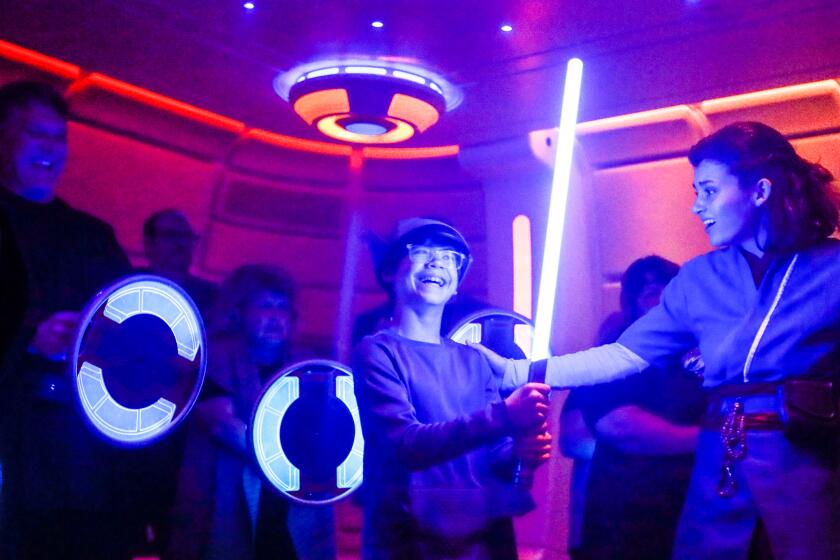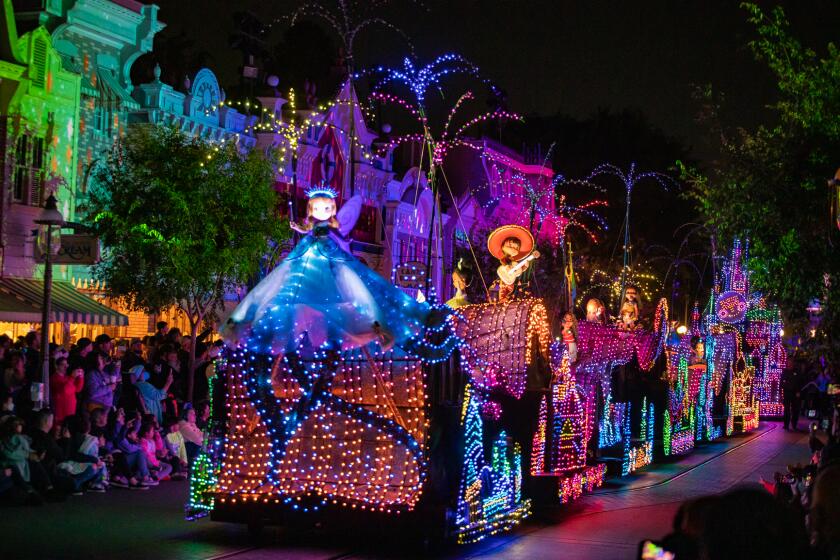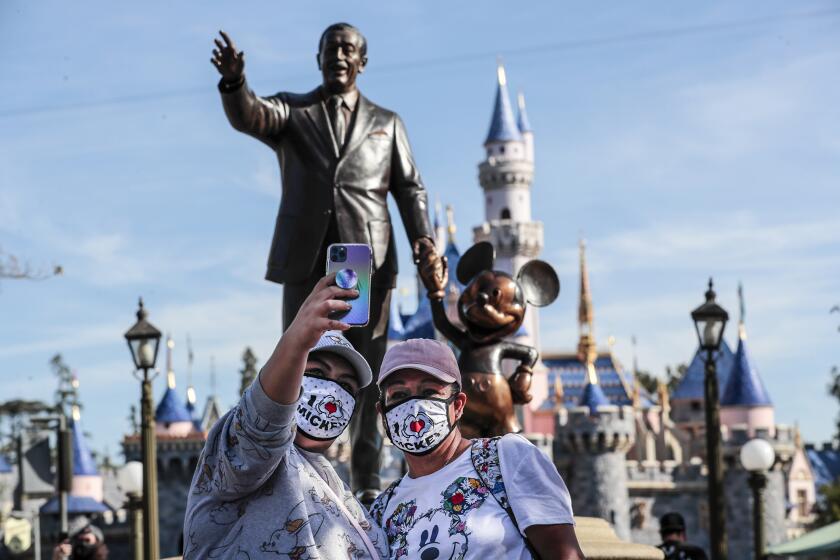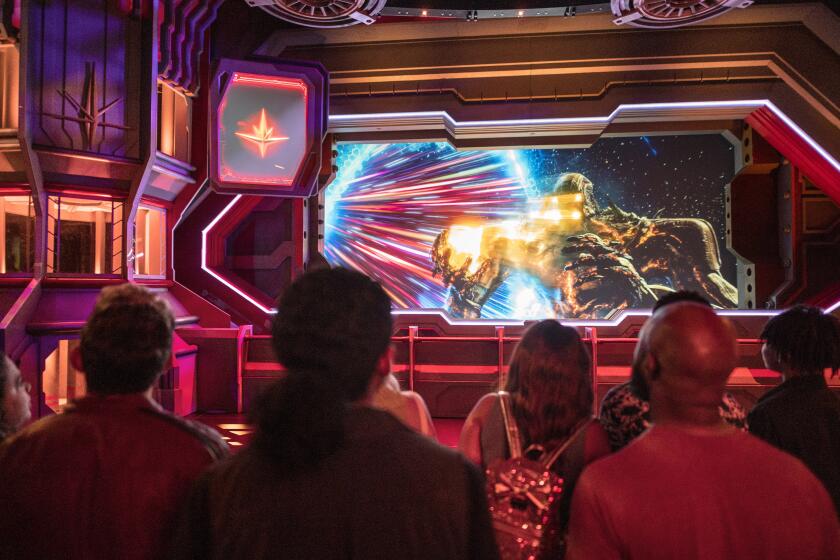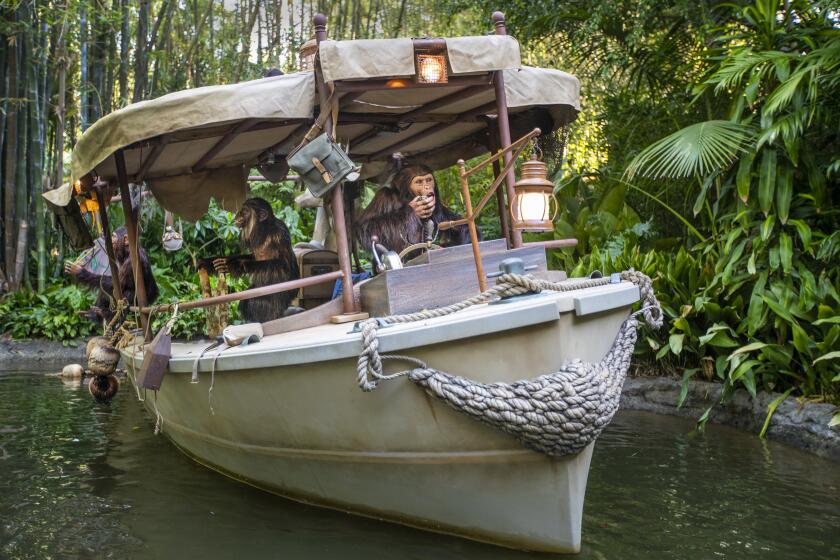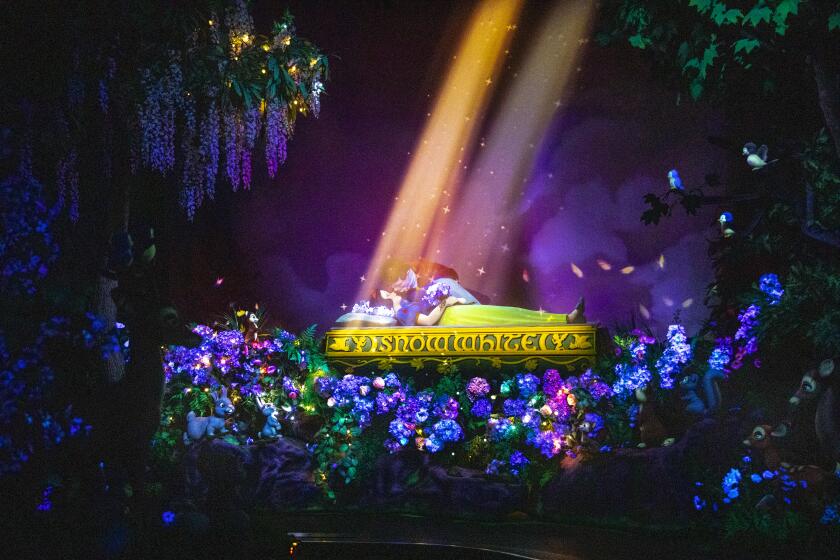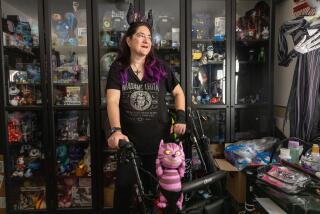- Share via
Regardless of how you feel about the crowds, the strollers and the high prices, Disneyland, like it or not, represents the American dream. When the pandemic forced the park, along with many of our other institutions, to close in March 2020, it was an exclamation point that we were entering a period without an archetypal ideal.
A ritual for many was gone, and a place designed to represent contentment could not operate. For Disneyland’s Main Street, U.S.A., isn’t a return to another era but a film set sprung to life, with facades that are alternately familiar and fantastical — there is a castle, after all, at the end of the strip. Taken together, Disneyland is designed to displace us and to transport us to a land of imagination. Even if briefly, we enter a period of timelessness.
No wonder fans wept when the Disneyland Resort reopened its gates on April 30, 2021. Disneyland had never closed for such an extended period in its 65-plus-year history, and after more than a year of uncertainty, where time stood still or time was lost, many began returning to a place where time doesn’t matter so much. Yes, there are lines and return times, but there’s also Frontierland and Tomorrowland, the romance of New Orleans Square or a Route 66 outpost (Cars Land) and of-the-moment technology at the new Avengers Campus that contrasts nostalgia with possibilities still to come.
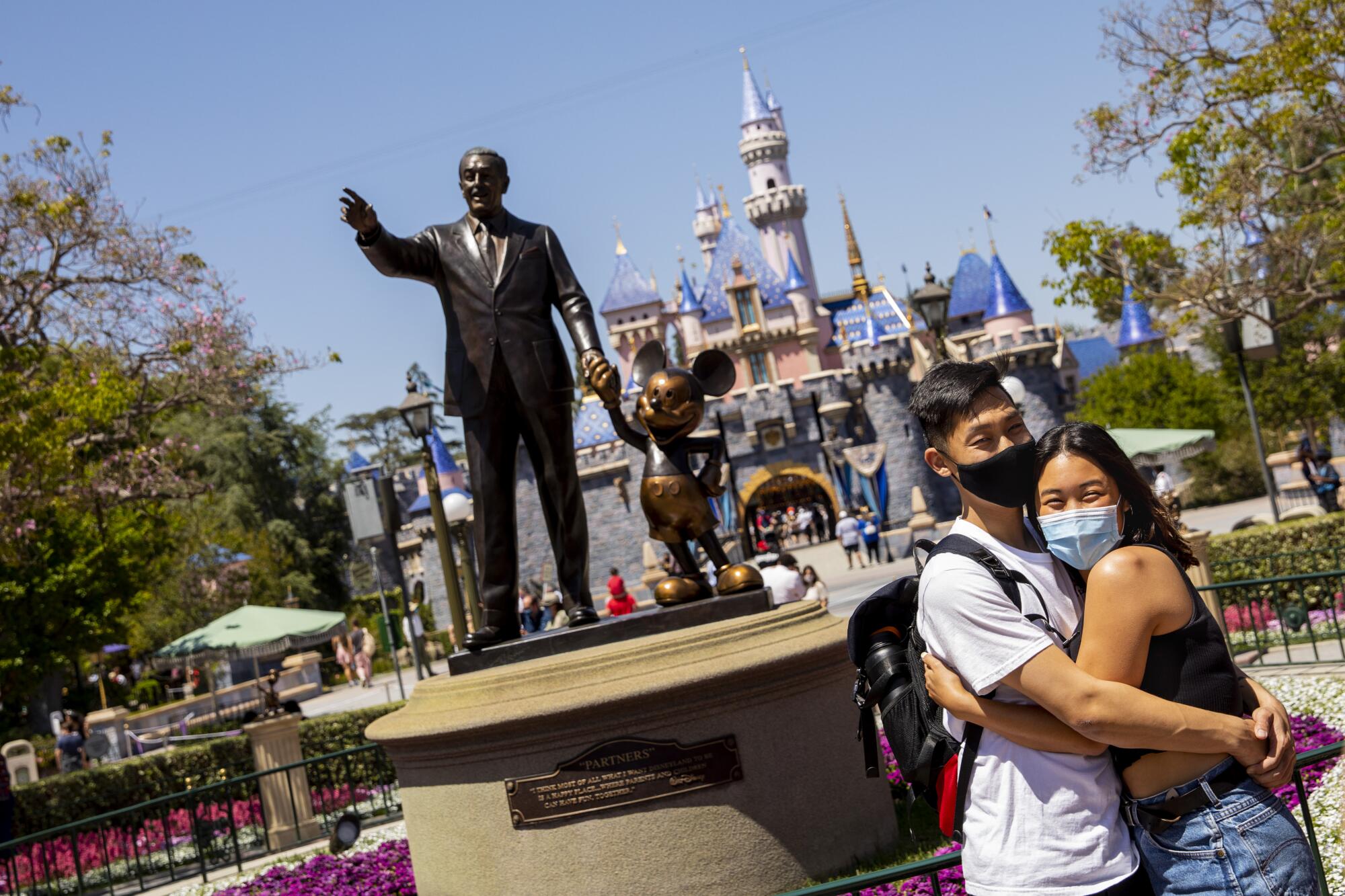
Death, impermanence and the fears that accompany those facts permeate Pirates of the Caribbean, the Haunted Mansion and even Mr. Toad’s Wild Ride, where eccentric vices aren’t judged and frivolity is idealized.
The consequences may be delivered with a jingle or a trick of the light, but these aren’t lectures of human indulgences. They are an acknowledgement of the human ability to persevere through life’s romanticism as well as its harsh realities, all via the stories we tell ourselves. Yes, it’s the age-old tale of good triumphing over evil, but it also shifts the theme park from a place of petty escapism into an establishment to help us make sense of our world.
It may be the most ambitious Disney theme park endeavor since Disneyland: Star Wars: Galactic Starcruiser, a live-action role-playing game for the 1%.
When placed inside worlds where the familiar gives way to fantasy, the pressures of a clock or the weight of another passing year can be let go. We are free at Disneyland to imagine and to play, and such a place seems more relevant than ever after two-plus years of unease.
And yet there is the ever-present nagging reality that Disneyland is no place of altruism but is instead a palace designed to highlight and promote corporate interests, all while enticing us to part ways with another dollar. While we can establish Disneyland’s importance, it’s worth checking in from time to time to see how the park is being stewarded, if leadership is not just upholding its ideals but also creating a place that is worthy of the hundreds of dollars it demands.
So now that Disneyland has been open a year, let’s take stock of how the park has changed in our pandemic era. With a new annual passport program, the erasure of the Fastpass ride system and the company’s battle with Florida Gov. Ron DeSantis, how Disneyland operates in 2022 is different than in 2019. This is our evaluation on the last 12 months that the park has been open.
Parks chairman Josh D’Amaro reflects on changes at Disneyland, now operating at close to full capacity one year after reopening following an extended pandemic closure.
Getting tickets: Reservations required

A trip to Disneyland today requires more planning than in the prepandemic past, largely due to the addition of a reservation system, which is separate from buying a ticket. To gain admission, you must buy a ticket, and then make sure to reserve a day to use that ticket. You must also pick a starting park — Disneyland or California Adventure — and you can’t park-hop until 1 p.m. Disneyland officials say this helps manage crowd flow and back-end operations and staffing, but let’s hope the policy is still under evaluation. If the park-hopping hours are here to stay, changing them from 1 p.m. to noon would be a better solution, giving guests the freedom they expect in plotting out rides and dining.
Waiting for the tram

Staffing in the park’s initial reopening months was at a noticeably low level and even affected getting to the park. Trams to usher guests from the parking lot to the park were out of commission for months, forcing visitors with disabilities into an uncomfortable position. This became a multimonth smear on the park’s usually strong accessibility practices; it was exacerbated when the company mostly stayed quiet about the status of the trams. Disney tried to make the vehicles’ return in late February into an event, but bringing back basic and expected services shouldn’t be a cause for celebration.
With COVID-19 abating in California, Disneyland reopened on April 30. After 13 months away, how did it feel?
Responding to the culture wars

Disney is not just a business leader but a cultural one as well. While that could be seen as unfair — especially when the microscope applied to Disney’s social stances isn’t equally focused on the company’s competitors and peers — such scrutiny comes with being the preeminent American theme park. A single film or TV show may not have the importance that social media ascribes to it (see all things Marvel and “Star Wars”), but no other company gives voice to as many creatives across as many disciplines as Disney.
Many of those creatives are part of the LGBTQ+ community — the Walt Disney Company consistently ranks as one of the best corporations for LGBTQ+ workplace equality. Thus, it was disappointing that the company was late in responding to its workers who asked Disney to voice dissent toward Florida’s so-called “Don’t Say Gay” bill.
When Florida Gov. Ron DeSantis responded to Disney’s mild statement against the state law by signing legislation revoking the company’s decades-old self-governing agreement, it called attention to the special status the corporation has enjoyed in Florida and incentives Disneyland has received in California from the city of Anaheim. But the outsized retaliation also generated sympathy for the multibillion-dollar company.
As far as giant corporations go, modern Disneyland is generally moving at a brisker pace than the Disneyland of old. Long overdue, for instance, was the branding announced last month for the park’s pride merchandise, now called “Disney Pride Collection,” after too many years of selling the rainbow-colored items without specific labeling. Yet even with these shifts, the company remains far from the “woke” status Florida Republicans want to assign it.
The Magic Key
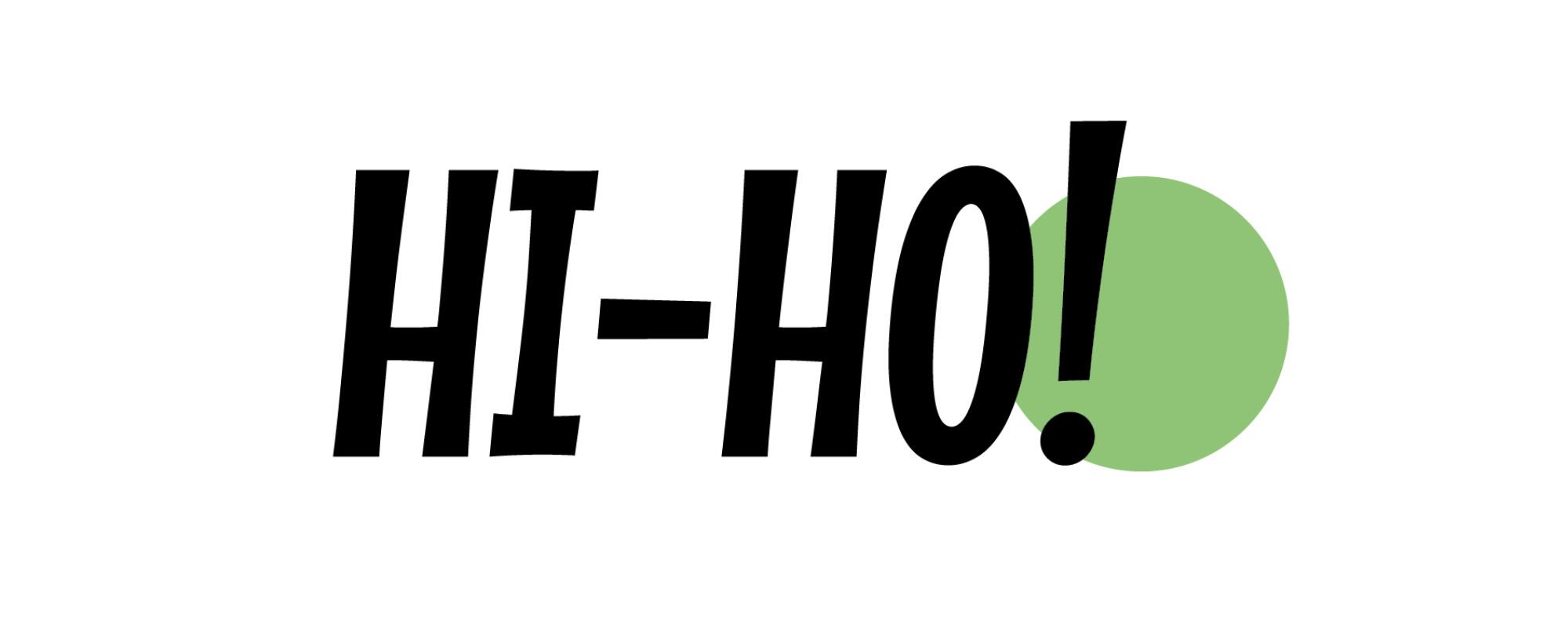
The company introduced a Magic Key loyalty program to replace its popular annual passport. For essentially the same price with less access, the Magic Key requires advance reservations that largely curtail the idea of a spontaneous visit. Weekend spaces go fast, and while reservations can be found at the last minute, you must be diligent about checking the site.
But take the good with the bad. The reservation system appears to be working in maintaining a healthy crowd level. So far, heavily trafficked days aren’t quite the headache that they were in prepandemic times; bottlenecks mostly occur during evening parades or fireworks. Ride wait times are also more manageable, although the addition of the line-shortening program Genie+ will alter this further.
Imagineers reveal lessons from Legends of Frontierland, one of Disneyland’s playtests that led to the gamelike live-in theme park Star Wars: Galactic Starcruiser.
The Magic Key system has proved so popular that its top two tiers remain sold out at press time, giving the company’s local, dedicated fanbase fewer options for more frugal visits and creating, intentionally or not, the perception that controlling local visits is more important than rewarding loyalty. The Magic Key program could use more options and tiers — perhaps a half-day ticket with a later starting time? For guidance, look to season ticket packages at sporting events, which can often be geared to specific perks or time of visits.
From Fastpass to Genie+

Those who utilized Disneyland’s line-skipping program Fastpass should expect to get acquainted with Genie and Genie+.
These programs are embedded in the Disneyland app and they can be daunting to those who haven’t used them before. Genie is a free recommendation system that gives not-so-helpful tips for planning your visit. It’s supposed to tell you, for instance, the best time to visit the Haunted Mansion or when you should break for a meal or snack. I find it steers me to attractions or dining options I’m less interested in, but infrequent visitors might learn from it about aspects of the park they shouldn’t miss.
Genie+ is where things get confusing if you’re plotting out a Disneyland trip for the first time since prepandemic days. For a fee — $20 per person per day — you get access to so-called “Lightning Lane entrances” at select attractions. This is the new Fastpass — you pick a return time via the app to visit the attraction. But in-demand rides, such as Rise of the Resistance or Radiator Springs Racers in Cars Land, require an additional fee — it varies, but expect to pay another $12 to $20 to access the Lightning Lane.
A review of the new Guardians of the Galaxy: Cosmic Rewind ride at Walt Disney World’s Epcot.
In the app, the line-skipping options are part of the Genie program under the “tip board” tab. This will give you current stand-by waits as well as options for return times. It should be noted that there is a contingent of the Disneyland fanbase that believes line-skipping programs increase standby wait times. Yet when spending a full day at the park, I can typically get eight attractions via Genie+, not including Rise of the Resistance or Radiator Springs Racers. I think it’s a worthwhile time saver.
My larger concern is that price increases seem inevitable, and it’s likely that new attractions will continue to be placed in the a la carte area of Genie+, making those rides out of reach for those on a tight budget. Another wrinkle is that Genie+ is really only of value if you plan to arrive early in the morning; by midafternoon, return times for rides dwindle. If you’re someone who prefers to show up around noon or later, Genie+ may not be a worthwhile purchase, especially if there’s a large number in your party.
Hugs and the pandemic response

The park deserves props for its initial safety precautions when it first reopened. Creative solutions, such as staging socially distanced character meet-and-greets and replacing daytime parades with character cavalcades, turned the park into a greater place of theater. Even as more standard meet-and-greets have returned, as well as hugs, the park has maintained the more separated interactions, creating a more lively atmosphere. Early on, the park visibly took COVID-19 seriously. In my first visits in April 2021, I was asked, politely, to keep my mask on between bites at restaurants, regulations that gradually and, albeit expectedly, went away.
The park ultimately followed Orange County’s looser pandemic rules — looser at least than Los Angeles County’s — dropping outdoor masking relatively early and opting not to require proof of vaccination despite venues such as Dodger Stadium illustrating it was easy to enforce. If there was a disappointment it was this, as Disney, especially during dangerous surges, wanted to be all things to every viewpoint. The better move would have been to more boldly advance the public good.
Keeping up with the times

Disney’s fairy tales and superhero stories help shape a cultural narrative, reflecting American ideas to a global audience. Its places — Disneyland and Walt Disney World Resort — are often seen as stand-ins for the company’s beliefs. And its stories are rooted in metaphors, whether they are in a centuries-old text, 20th century film or a warehouse full of blacklight-reactive structures and pirate robots. They represent their era, sometimes unintentionally so. What is, for instance, the still-new Star Wars: Galaxy’s Edge but a modern tale of the haves and have-nots amid a struggle of belief over a sometimes misinterpreted faith?
Yet even as it conveys a sense of timelessness, Disneyland has been more aggressive about responding to changing times. Before reopening, Disneyland announced that it will rebrand Splash Mountain, replacing the ride’s connection to the racist text of “Song of the South” with “The Princess and the Frog,” the film that starred the company’s first Black princess. It’s a smartly inclusive move for Disneyland, even if the company is short on providing updates.
This is just one tweak Disneyland has planned to make existing attractions more palatable to modern audiences. Last summer, the Jungle Cruise was updated to remove, in Disney’s words, “negative depictions of native people.” In their place are slapstick-inspired scenes largely involving chimpanzees and monkeys getting the best of a prior Jungle Cruise expedition. Finally gone are the ride’s uncomfortable images of Western colonialism.
The new Jungle Cruise shows Disney wants to be in the cultural conversation rather than an artifact or, worse, a representation of the ‘good ole days.’
It would have been nice if the park hadn’t waited until there was a “Jungle Cruise” movie to promote, but the updates show that Disneyland understands that it’s a place of living art, and that the park’s attractions must better represent the diversity of its audiences.
Festival of Holidays at Disney California Adventure, for instance, is a boisterous celebration of Latin art and music anchored by the ¡Viva Navidad! street parade featuring the Donald Duck-led Three Caballeros. The festival also recognizes Hanukkah and Kwanzaa, among other cultural traditions. California Adventure celebrates Lunar New Year with Mulan and increasingly goes deep on Día de los Muertos thanks to a little help from “Coco.” The park even boasts a “Black Panther”-inspired training session that takes seriously the multiple African-inspired cultures of the fictional Wakanda by creating a show anchored in philosophical lessons.
Disney also announced that its staff — cast members, in park parlance — would have more freedom in how they appear for work, including the ability to choose gender-inclusive costumes and hairstyles. They also no longer have to hide their body art. Such moves received some pushback from the cultural right, arguing that Disney is getting “woke.” Yet others could argue there are still ways to grow, such as allowing cast members to wear the very pride pins it sells.
New rides and attractions

The pandemic delayed the opening of Avengers Campus, which at long last brought Marvel characters into the park. At 6 acres, Avengers Campus isn’t a transportive place such as the 14-acre Star Wars: Galaxy’s Edge next door at Disneyland, but it has different objectives. Namely, it’s a place to interact with superheroes, and Disney and Marvel have done a solid job in quickly bringing in characters from the latest Disney+ shows and MCU films. Web Slingers: A Spider-Man Adventure is a video-game ride that shows the power of theme parks, giving us something we can do only in a physical realm — that is, eject virtual webs from our wildly motioning hands.
Since it is so heavily game-like and screen-based, the attraction may feel slight compared with more majestic additions such as Star Wars: Rise of the Resistance. But it builds out the Disneyland portfolio with a family-friendly ride designed to inspire goofiness. The land, with its office park feel and very little shade, does feel unfinished, however — an Avengers-focused ride that was supposed to be part of a second phase remains on indefinite hold for now (Disney CEO Bob Chapek stated at a shareholder meeting that the company hopes to revive the project in the future).
Disneyland Imagineers anticipated criticism of the inclusion of ‘true love’s kiss’ in its Snow White ride redo. How they worked to empower Snow White.
Beyond the previously mentioned Jungle Cruise update, another notable ride change occurred at Disneyland’s classic “Snow White and the Seven Dwarfs”-inspired dark ride. Now known as Snow White’s Enchanted Wish instead of Snow White’s Scary Adventures, the ride wraps its arms around feelings of adoration, endearment, friendship and the hope that, via love, we don’t become rescued so much as better versions of ourselves. There are tech updates throughout, and the refresh ever-so-slightly reframes the ending. No longer is the prince leading Snow White out of the forest to a mystical castle in the sky. Snow White is instead back in the forest, hanging with her animal friends, while her suitor patiently waits for her in the distance.
Food and drink

If one area remains a frustration for Disneyland’s day guests and Magic Key holders, it’s dining. Sit-down restaurants in particular have been behind other park operations in reaching full capacity. Menus across the resort are smaller than they were prepandemic, and reservations can sometimes feel impossible to snag. Tables at in-demand restaurants such as Lamplight Lounge or Carthay Circle in Disney California Adventure are particularly tricky to find, as is a reservation at Oga’s Cantina in Star Wars: Galaxy’s Edge.
It’s possible to snare a walk-up, but not every guest knows that to do so requires a near constant refresh of the Disneyland app’s dining page while standing in proximity to the restaurant or bar. This can become a time-consuming waste of one’s day. I generally budget 20 or 25 minutes to stand near Oga’s while constantly refreshing the Disneyland app to get a reservation on days that visiting the cantina is a priority.
If you’re looking for nonalcoholic dining options, it’s typically easier to get a walk-in dining reservation over at Disneyland, either at Carnation Cafe on Main Street or Cafe Orleans in New Orleans Square. But if dining at the resort is one of your priorities, know that this is one area that preplanning likely won’t help; go in with the expectation you’ll need to be flexible. The Disneyland Hotel’s Steakhouse 55 hasn’t reopened or been reimagined, which also leaves the resort without a key high-end dining option to complement Napa Rose. Even tiny locales, such as Trader Sam’s Enchanted Tiki Bar, also at the Disneyland Hotel, remain especially in-demand and difficult to visit.
The path ahead

A number of additions and changes are coming to the Disneyland Resort over the next year or two that should result in an overall better experience. Up soon is a rebranding of Tarzan’s Treehouse, a remodeling that should free up a bounty of walkway space in Adventureland. Next year sees the addition of the delightful Mickey & Minnie’s Runaway Railway, a Walt Disney World import that will turn Mickey’s Toontown into a must-visit for all ages. And there are changes coming to Downtown Disney that will add more dining options, including the popular dumpling restaurant Din Tai Fung.
In the near-term, it’s expected that Disneyland will continue to ramp up its offerings to prepandemic levels. Here’s hoping that the daytime parade Magic Happens makes a comeback and that Disney finds a new Broadway-style show for its Hyperion Theater in Disney California Adventure. More technology is also on the way, such as the Magic Band+, wristbands that can unlock hotel rooms and create in-park interactions.
Regardless, Disneyland has stood as a marker of consistency since 1955. Its core formula remains stronger than the whims of any of its landlords.
More to Read
The biggest entertainment stories
Get our big stories about Hollywood, film, television, music, arts, culture and more right in your inbox as soon as they publish.
You may occasionally receive promotional content from the Los Angeles Times.
